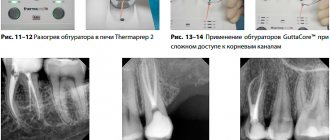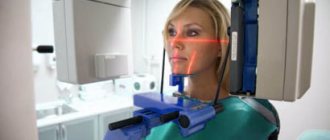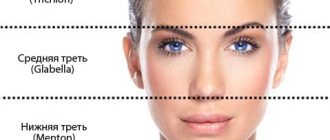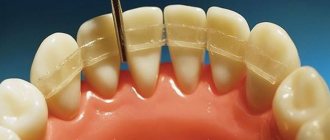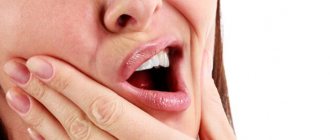2020 Michael Solomonov DMD, Alex Lvovsky DMD, Vered Katzenell DMD, Joe Ben Itzhak DMD, Elena Lipatova, Yehuda Zadik DMD, MHA
(.pdf)
Drug-induced osteonecrosis of the jaw (MRONJ)1 is an emerging area in endodontic practice. The article briefly reviews the currently available literature on the topic, compiles the current list of treatments that lead to MRONJ, and offers practicing endodontists a framework for identifying patient predisposition factors for MRONJ.
Osteonecrosis of the jaw
The MRONJ is defined by the American Association of Oral and Maxillofacial Surgeons (AAOMFS) [9] and the American Society for Bone and Mineral Research [10] as the area of exposed bone ( or exposed bone, or bone that can be probed through an intraoral or extraoral fistula [9] in the maxillofacial area that does not heal within 8 weeks of discovery by a healthcare professional [10], in a patient who has received or has been exposed to anti- resorptive (or anti-angiogenic [9]) medications and who have not received radiation therapy to the craniofacial area (or obvious metastatic disease to the jaw [9]).These organizations have developed stepwise systems for MRONJ with suggested treatments at each step:
- Stage 0: There is no exposed bone and no dead areas are found on the x-ray. Prescribe treatment depending on symptoms and control of local factors;
- Stage 1: Exposed bone or fistula leading to bone, but no signs of infection. Should be treated by rinsing the mouth with antiseptic solutions (eg chlorhexidine digluconate), surgical intervention is not indicated;
- Stage 2: exposed bone or fistula leading to bone, with signs of infection (usually symptoms). Therapy with antimicrobial mouth rinses and systemic antibiotics (eg penicillin) is necessary;
- Stage 3: exposed bone with complications such as pathological fractures, oroantral communication, or additional oral fistulas. They can be treated with surgery, including resection in combination with antibiotics [9, 10]. (Fig. 1).
Diagnosis and classification
There are 3 main methods for diagnosing the disease:
- radiography;
- biochemical blood test, general blood and urine analysis;
- bacteriological culture of discharge from a purulent focus.
X-rays also help identify foci of sequestration, areas with coarse-fibered bone tissue, areas of osteosclerosis and uneven contours.
Based on the diagnostic results, the doctor determines the type of necrosis:
- odontogenic - develops due to dental diseases;
- hematogenous - the infection spreads through the bloodstream;
- traumatic - after a jaw injury.
The diagnosis also determines the degree of necrosis:
1st - bone tissue is destroyed by 10%, the functions of the jaw are not yet impaired;
2nd - microcracks in the bone, pain, restrictions in movements of the maxillofacial area;
3rd - more than 50% of tissues are affected, constant pain;
4th - massive bone destruction.
According to the nature of the course, osteonecrosis can be acute, subacute or chronic. Taking into account all these factors, the doctor chooses a treatment method.
List of medications that can cause osteonecrosis of the jaw
A list of drugs that can cause MRONJ has been compiled, evidence and reports have been collected, and an increasing number of non-bisphosphonate drugs are now known to be associated with it, either by themselves or by increasing the risk associated with bisphosphonate MRONJ; Thus, some medications do not cause MRONJ unless they are given with a bisphosphonate, and the patient is then at higher risk of developing osteonecrosis of the jaw compared to patients taking a bisphosphonate alone.
In addition to bisphosphonates, the list of such medications includes denosumab, bevacizumab, sunitinib.
Cases of MRONJ have also been associated with the following medications: aflibercept, azacitidine everolimus, imatinib, pazopanib, sorafenib, tocilizumab and trastuzumab and have been described (Table 1) [9, 11–19]. Consequently, the AAOMFS changed the term for this phenomenon from bisphosphonate-dependent to drug-dependent MRONJ [9]. Table 1. List of medications that can cause the development of MRONJ
| Category | A drug | Commercial name | Main indicators | Mechanism of action | Risk level |
| Antiresorptive | Pamidronate | Aredia | Bone malignancies | Bisphosphonate (IV) | High |
| Zolendronate | Zometa, Aclasta | Bone diseases and malignancies | Bisphosphonate (IV) | High | |
| Alendronate | Fosalan, Fosamax | Bone diseases | Bisphosphonate (oral) | Moderate | |
| Ibandronate | Boniva | Bone diseases | Bisphosphonate (oral) | Moderate | |
| Risedronate | Actonel, Atelvia, Benet | Bone diseases | Bisphosphonate (oral) | Moderate | |
| Denosumab | Prolia, Xgeva | Bone diseases and malignancies | RANKL inhibitor | High | |
| Targeted therapy | Bevacizumab | Avastin | Malignant formations | VEGF inhibitor | High |
| Sunitinib | Sutent | Malignant formations | Tyrosine kinase inhibitor | High | |
| Imatinib | Gleevec | Malignant formations | Tyrosine kinase inhibitor | Unknown* | |
| Pazopanib | Votrient | Malignant formations | Tyrosine kinase inhibitor | Unknown* | |
| Sorafenib | Nexavar | Malignant formations | Kinase inhibitor | Unknown* | |
| Tocilizumab | Actemra, RoActemra | Autoimmune diseases | Interleukin-6 receptor antibody | Unknown* | |
| Trastuzumab | Herceptin | Malignant formations | HER2/neu receptor antibody | Unknown* | |
| Azacitidine | Vidaza | Myelodysplasia | Nucleotide Analog | Unknown* | |
| Everolimus | Zortress, Certican, Afinitor, Votubia, Evertor | Malignancies and prevention of organ rejection | mTOR inhibitor | Unknown* | |
| Aflibercept | Eylea, Zaltrap | Colorectal malignancies | VEGF inhibitor | Unknown* |
*Only in documented cases.
What should you consider when deciding whether to take bisphosphonates or denosumab?
When deciding whether to take these medications, it is important to consider both the small risk of developing ONJ and the known benefit of protecting bone tissue. These medications prevent fractures in bones that are weakened by osteoporosis, osteopenia, or cancer. Sometimes broken bones or related problems are quite serious. They can pose a threat to life or lead to disability (depriving the ability to engage in certain activities). Your doctor thinks that the benefits of taking these medications outweigh the small risk of developing ONJ. But only you can make the decision. Discuss this issue with your doctor.
to come back to the beginning
Identification of patients at risk
Identification of a dental patient at risk is achieved through a thorough review of the medical history, the use of a structured questionnaire, an interview with the patient, and close interaction with the patient's previous treating physicians regarding the presence of current diseases and medication use on an ongoing basis [20]. Although, since bisphosphonates may not be prescribed on a daily basis (for example, weekly, bimonthly or monthly, or intravenously once a year), the patient and even his or her primary care physician may not consider these medications to be “continuous medications” [21]. , 22]. Moreover, those patients who no longer take bisphosphonates are still at risk of developing osteonecrosis of the jaw [9], but they will not list this drug in the medication column unless the dentist asks the patient about the medications that were taken previously [22]. Consequently, the fact that these drugs are being taken may be overlooked and a patient at risk may not be identified. Situations have been identified where a patient does not remember the names of previously taken medications, especially if there were several of them, as well as cancer patients who have been prescribed many medical protocols over the past years. The dentist should be familiar with the indications for the use of these medications and seek information from reliable sources about previous medication use (for example, hospital records), especially with patients who suffer from the following diseases: multiple myeloma associated with metastatic or osteolytic lesions, malignant tumors (such as breast, prostate or lung cancer), cancer-related hypercalcemia, osteoporosis, osteopenia, chronic corticosteroid administration, Paget's disease, osteogenesis imperfecta, juvenile osteoporosis, fibrous dysplasia and Gaucher disease [23].
Another possible reason for failure to identify an at-risk patient is non-bisphosphonate medications, which are associated with the development of MRONJ. Even those dentists who are familiar with the harmful effects of bisphosphonates may not be aware of these medications. Thus, dentists may miss these patients even if the person or their physician has provided a complete medical history [20]. Therefore, the dentist should be aware of the increased risk of osteonecrosis of the jaw associated with the above-mentioned drugs, as well as keep up to date with the latest research on this topic, since it is likely that new drugs will be added to this list of MRONJ-causing drugs in the future.
What increases the risk of ONJ?
The risk of ONJ increases the longer your treatment with bisphosphonates or denosumab lasts. And because patients taking these drugs to treat cancer typically do so for a longer period of time and at higher doses than those taking it to treat osteoporosis, they are at greater risk of developing ONJ. Patients with multiple myeloma are also likely to be at greater risk of developing ONJ.
You are also at increased risk for ONJ if you have had dental surgery while taking these medications.
to come back to the beginning
Treatment plan for an at-risk patient
In patients with a history of taking bisphosphonates or other mentioned medications, MRONJ may occur after oral surgical procedures, due to local inflammation, or without any objective cause [24–26]. There is also a risk of developing osteonecrosis of the jaw around long-standing osseointegrated dental implants, even if bisphosphonates were started long after successful osseointegration [27, 28].
Therefore, in accordance with the AAOMS protocol [9], when working with patients undergoing intravenous bisphosphonates (bevacizumab, denosumab or sunitinib), any surgical procedures, including tooth extraction, implant placement, apical surgery, etc., should be avoided. d. In patients who have been taking oral bisphosphonates for more than 4 or less than 4 years but who have other risk factors for developing MRONJ (eg, long-term corticosteroid therapy, chronic anemia, unbalanced diabetes mellitus, or other conditions that affect wound healing), the dentist should consider the need for dental surgery, including apical surgery, and if surgical manipulation is necessary, then the prescription of drugs should be considered with the attending physician [9], along with atraumatic procedures, a course of antibiotics and local antiseptic treatment. Some clinicians perform surgery only in at-risk patients whose serum c-terminal peptide levels are >150 μg/m2 [29, 30].
To avoid surgery in at-risk patients, clinicians should attempt to preserve their teeth even if they are considered unrestorable; The recommended manipulation of such teeth is root canal treatment (or retreatment, if necessary), closing the canal with a restorative material (for example, amalgam or glass ionomer cement) and performing decoronation (that is, filing the coronal part to the level of the gum) (Fig. 2).
The fact that osteonecrosis of the jaw can appear around dental implants many years after successful osseointegration [27, 28] (Fig. 3) calls for a paradigm shift. The practice of removing teeth with various lesions and installing implants in their place without attempting to cure the tooth should be stopped. Premature removal and implantation in young patients may have consequences much later when that patient begins taking (orally or intravenously) a bisphosphonate or other MRONJ-promoting drugs for adult-onset disease.
MRONJ and endodontic manipulations
Apical periodontitis
As mentioned previously, MRONJ may occur after oral surgery or due to local inflammation (eg periodontitis) [25]. In particular, ONJ can manifest itself due to an inflammatory process in the alveolar bone, such as apical periodontitis (Fig. 4) [31]. Since endodontic treatment in itself does not increase the risk of developing MRONJ, while apical periodontitis does, endodontic treatment is indicated, especially before the prescription of antiresorptive drugs.
Apical surgery
Since all surgical procedures, to one degree or another, involve working with the bone tissue of the jaw, there is a risk of developing osteonecrosis after apical surgery in patients who took the previously mentioned drugs, as well as after apical periodontitis. It is also worth taking into account the indications for this surgical procedure. If surgery is indicated, the surgeon should adhere to the guidelines described above in the section on surgical planning.
Subgingival clasps
During endodontic treatment of a high-risk patient, the dentist should not use subgingival clasps for rubber dam isolation, since the use of this type of clasp can damage oral tissue and cause MRONJ [32]. Currently, there are multiple atraumatic techniques for isolating teeth, with or without clasps, such as ligature bonding, spit dam techniques, core restoration using a supragingival clasp, and the use of a projection technique for approaching canals [33–35].
Vertical root fracture
Vertical tooth root fracture requires special attention, since there is currently no effective therapy to save such teeth. Among endodontically treated teeth that were extracted, 10–36% were extracted due to vertical root fracture [36, 37]. Multiple manipulations during endodontic therapy and prosthetics can cause fracture, including factors such as excessive dentin removal [38], the destructive effect of chemicals [39, 40] and inappropriate obturation techniques [41, 42]. Factors associated with prosthetic restoration include additional dentin removal, the creation of permanent stress on the root dentin [43], and inappropriate selection of intracanal materials [44].
The occurrence of a vertical root fracture in a patient at risk for developing MRONJ is a mystery because removal of the affected tooth may result in osteonecrosis of the jaw [45], but preservation of the tooth may also lead to MRONJ due to inflammation of the surrounding bone tissue (in addition to deterioration of bone quality). life due to acute pain). Vertical fracture is the only indication for tooth extraction in at-risk patients, although clinicians should adhere to strict methodology, including atraumatic techniques (referral is also recommended), systemic local antimicrobial treatments, and avoidance of filling the socket with any intended materials.
As always, prevention is the best approach to preserving tooth vitality [46], but if this is not possible, then the use of a minimally invasive endodontic and prosthetic approach is mandatory [47]. Minimally invasive endodontic techniques include conservative access cavity preparation [48], avoidance of instruments with a taper greater than 6% [49–51], and avoidance of large apical extensions [52, 53]. Moreover, the emphasis should be on tools and techniques that reduce the risk of microcrack formation [54–56]. The use of medium concentration (i.e. 2.5–3.5%) sodium hypochlorite is recommended [39, 40]. If necessary, short-term investments of calcium hydroxide are possible according to indications [57], but for a period of no more than 1 month [58]. During the obturation process, the use of NiTi spreaders [59] and pre-fitted pluggers [60, 61] is recommended.
In prosthetic aspects, intracanal structures should be avoided [62, 63] or, if absolutely necessary, the space should be prepared by removing obstructive material with a heat plugger [64]. The channel for the anchor pin/cast inlay should be prepared to the maximum length [65] that will not compromise apical sealing [66, 67] and unnecessary removal of healthy dentin [64]. Bonding of a cast inlay is recommended with a venting (groove) to avoid stress in the root dentin [68].
Therapy methods
Treatment of necrosis is long and quite complex. But with timely treatment, the prognosis for treatment of necrosis of both the lower and upper jaw is quite favorable (although damage to the upper jaw bone is considered more dangerous).
First, it is necessary to eliminate the primary purulent focus: remove the tooth, prescribe anti-infective drugs or surgically treat wounds after injury. Then the dental surgeon opens the purulent formations, carries out antiseptic treatment and prescribes antibiotics, painkillers, anti-inflammatory drugs, as well as agents for tissue regeneration.
Also, after removing dead tissue, the dentist can strengthen the teeth using splinting. As additional measures, doctors can prescribe hyperbaric oxygen therapy, ultraviolet irradiation of blood, plasmapheresis, local physiotherapy, including the use of ultrasound and UHF. If, due to chronic necrosis, it is necessary to remove areas of bone tissue, then these areas are filled with special materials with antibiotics.
conclusions
The advent of MRONJ is changing modern dental practice. Despite relatively little attention in the endodontic literature, endodontics itself plays an important role in preventing the development of MRONJ through maintaining the integrity of the dentition, proper preparation of teeth before starting medications, and competent management of patients at risk. Endodontic treatment and decoronation of non-restorable teeth as an alternative to tooth extraction is a powerful tool in preventing the development of MRONJ in at-risk patients. The endodontist should identify such patients as early as possible, as well as MRONJ lesions.
As mentioned earlier, osteonecrosis of the jaw can develop many years after surgery, even if the procedure was performed while the patient was not
under the influence of antiresorptive treatment. This incredibly important discovery has enormous implications for dental practitioners, as teeth treated incorrectly in the past can lead to significant problems and suffering for the patient in the future. As patients get older every year, more and more of them may begin to require antiresorptive therapy. Great care must be taken to preserve the natural structure of the teeth by using minimally invasive dental procedures on all patients to reduce the susceptibility to vertical root fracture. Finally, the endodontist should consider MRONJ when diagnosing maxillofacial and oral pain in at-risk patients, even if there is no exposed oral bone.

